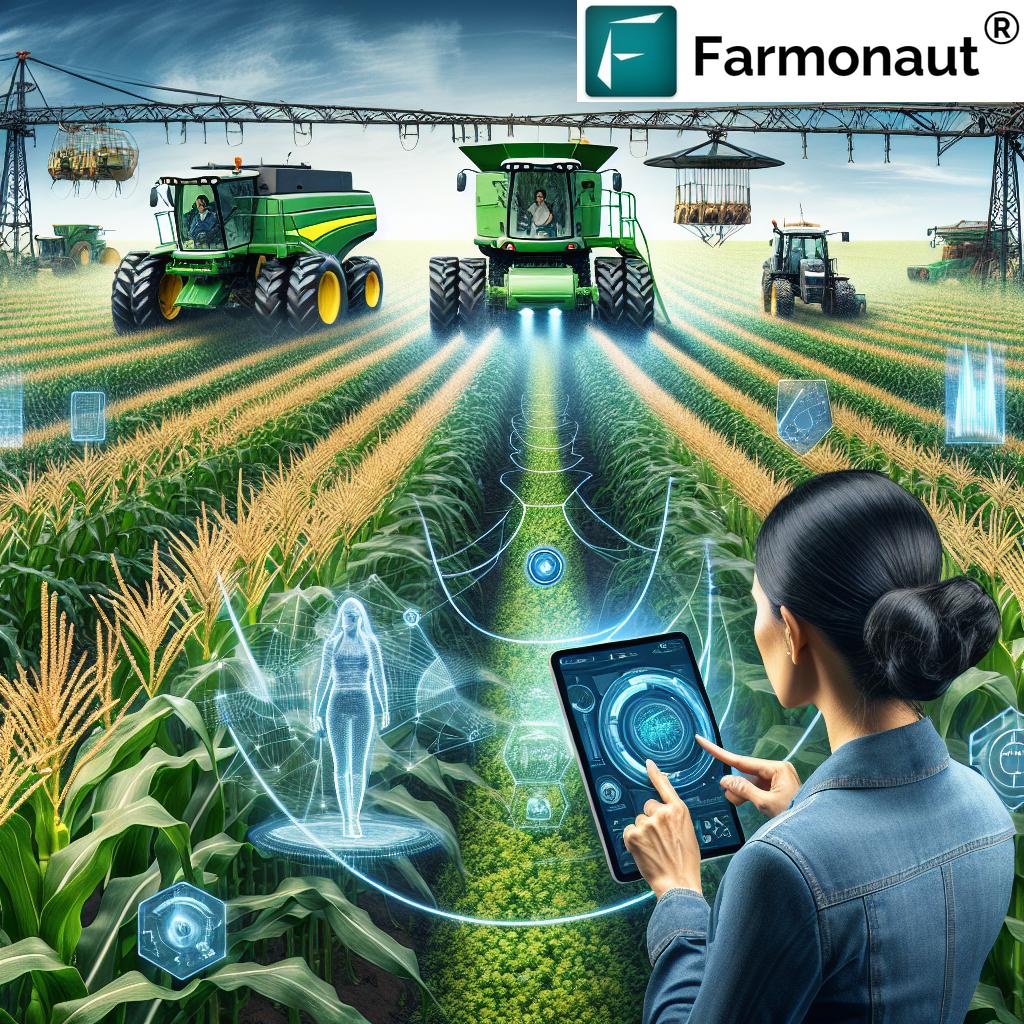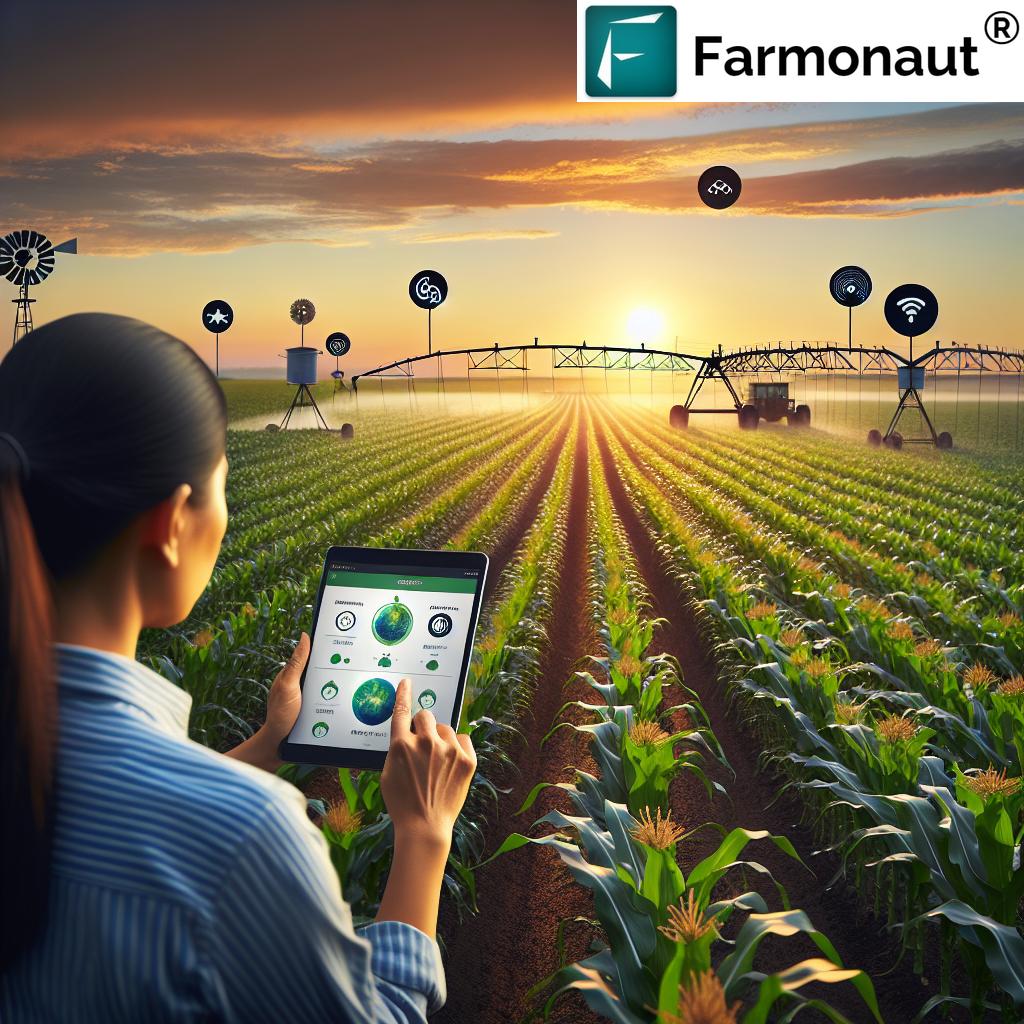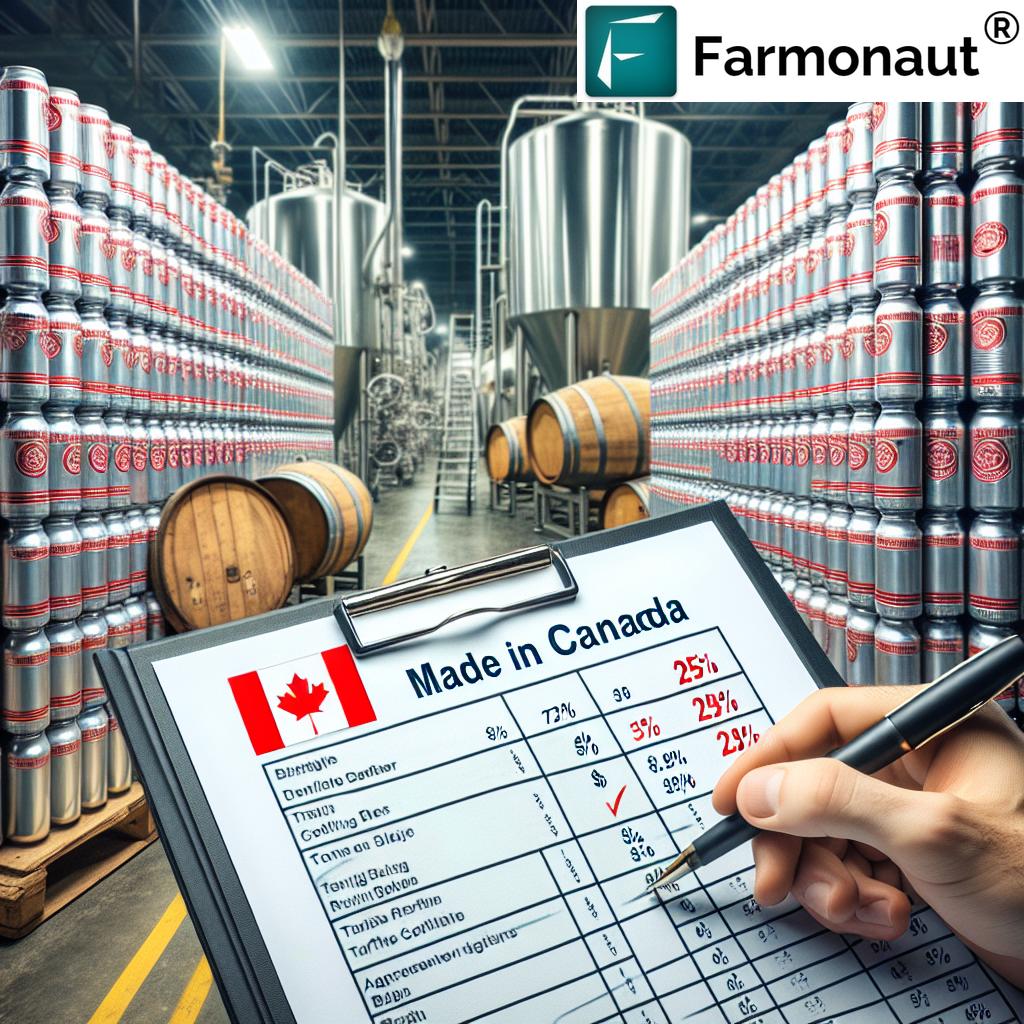Navigating Challenges in Ohio’s Agriculture: Precision Farming Strategies for Crop Yield Optimization
“Ohio farmers face dual challenges: corn and wheat production fluctuations alongside rising costs for 85% of farm inputs.”
Welcome to our comprehensive exploration of the evolving landscape of Ohio’s agriculture sector. As we delve into the intricate world of precision farming and crop yield optimization, we’ll uncover the challenges and opportunities facing farmers in the Buckeye State. Our journey will take us through the latest agricultural market trends, innovative farming techniques, and the role of cutting-edge technologies in shaping the future of farming.
The Current State of Ohio’s Agricultural Market
Ohio’s agricultural industry is a cornerstone of the state’s economy, but it’s facing a period of significant transformation. Farmers are grappling with a complex web of challenges, from fluctuating commodity prices to the rising costs of essential inputs. Let’s break down the key factors influencing the market:
- Commodity Price Volatility: Corn and wheat, two of Ohio’s primary crops, have experienced significant production fluctuations, leading to unpredictable market conditions.
- Input Cost Inflation: The cost of farm inputs, including seeds, fertilizers, and equipment, has been on an upward trajectory, squeezing profit margins for many farmers.
- Supply Chain Disruptions: Global events have caused ripples through the agricultural supply chain, affecting everything from fertilizer availability to equipment delivery times.
These challenges have created a pressing need for farmers to adopt more efficient and data-driven approaches to agriculture. This is where precision farming strategies come into play, offering a beacon of hope for crop yield optimization and sustainable farm management.
[Image 1]
Precision Agriculture Technologies: A Game-Changer for Ohio Farmers
Precision agriculture technologies are revolutionizing the way Ohio farmers approach crop production. By leveraging data analytics, satellite imagery, and advanced machinery, farmers can make more informed decisions that lead to improved yields and resource efficiency. Here’s how these technologies are making a difference:
- Satellite-Based Crop Monitoring: Advanced satellite imagery allows farmers to track crop health in real-time, identifying issues before they become visible to the naked eye.
- Variable Rate Technology (VRT): VRT enables farmers to apply inputs like fertilizers and pesticides at varying rates across their fields, optimizing usage and reducing waste.
- Soil Mapping and Analysis: Detailed soil maps help farmers understand the variability in their fields, allowing for targeted interventions and improved crop management.
At Farmonaut, we’re at the forefront of this technological revolution. Our satellite-based farm management solutions provide farmers with the tools they need to make data-driven decisions. From our web app to our mobile applications available on Android and iOS, we’re making precision agriculture accessible to farmers of all scales.
[Youtube Video: Farmonaut’s Tech Advancements in Q3]
Innovative Farming Techniques for Crop Yield Optimization
As we navigate the challenges in Ohio’s agriculture sector, innovative farming techniques are emerging as key drivers of crop yield optimization. These methods combine traditional agricultural wisdom with cutting-edge technology to maximize productivity while promoting sustainability. Let’s explore some of the most promising approaches:
- Conservation Tillage: This technique minimizes soil disturbance, helping to preserve soil structure and reduce erosion.
- Cover Cropping: Planting cover crops between growing seasons improves soil health and reduces the need for synthetic inputs.
- Precision Irrigation: Advanced irrigation systems use real-time data to deliver water precisely where and when it’s needed, conserving this precious resource.
- Integrated Pest Management (IPM): IPM strategies combine biological, cultural, and chemical methods to control pests while minimizing environmental impact.
These innovative techniques are not just theoretical concepts; they’re being successfully implemented by forward-thinking farmers across Ohio. By adopting these methods, farmers are seeing tangible benefits in terms of yield increases, cost savings, and improved soil health.
“Geopolitical tensions have disrupted fertilizer supply chains, affecting up to 40% of global agricultural productivity in recent years.”
Addressing Fertilizer Supply Chain Challenges
The fertilizer supply chain has been particularly vulnerable to global disruptions, presenting a significant challenge for Ohio farmers. Geopolitical tensions and market volatilities have led to price fluctuations and availability issues for essential nutrients. Here’s how farmers and the industry are adapting:
- Precision Application: Using technologies like variable rate applicators to optimize fertilizer use and reduce waste.
- Alternative Nutrient Sources: Exploring organic fertilizers and bio-stimulants as supplements to traditional synthetic fertilizers.
- Soil Health Management: Implementing practices that naturally enhance soil fertility and reduce dependency on external inputs.
At Farmonaut, we understand the critical role of proper nutrient management in crop yield optimization. Our API and developer documentation provide access to valuable data that can help farmers make informed decisions about fertilizer application, ensuring optimal use of these valuable resources.
[Image 2]
The Role of Agricultural Data Analytics in Farm Management
In today’s digital age, agricultural data analytics has become an indispensable tool for effective farm management. By harnessing the power of big data, Ohio farmers can gain unprecedented insights into their operations, leading to more informed decision-making and improved outcomes. Here’s how data analytics is transforming farm management:
- Predictive Analytics: Using historical data and machine learning algorithms to forecast crop yields, pest outbreaks, and weather patterns.
- Performance Tracking: Monitoring key performance indicators across different fields and crops to identify areas for improvement.
- Resource Optimization: Analyzing input usage patterns to identify opportunities for efficiency gains and cost savings.
- Market Intelligence: Leveraging data on commodity prices and market trends to inform planting and selling decisions.
Farmonaut’s Jeevn AI Advisory System exemplifies the power of agricultural data analytics. By combining satellite imagery, weather data, and machine learning, we provide farmers with personalized recommendations that can significantly enhance their farm management strategies.
[Youtube Video: Farmonaut’s Remarkable Half-Year Achievements 2023!]
Sustainable Crop Production: Balancing Productivity and Environmental Stewardship
As Ohio farmers strive to optimize crop yields, there’s a growing recognition of the need to balance productivity with environmental sustainability. Sustainable crop production practices not only benefit the ecosystem but also contribute to long-term farm viability. Here are some key strategies being adopted:
- Crop Rotation: Diversifying crop sequences to improve soil health and break pest cycles.
- Precision Nutrient Management: Using soil testing and variable rate technology to apply fertilizers more efficiently.
- Water Conservation: Implementing drip irrigation and other water-saving technologies to reduce water usage.
- Carbon Sequestration: Adopting practices that increase soil organic matter and capture atmospheric carbon.
At Farmonaut, we’re committed to supporting sustainable agriculture. Our platform includes features for carbon footprint tracking, enabling farmers to monitor and reduce their environmental impact while optimizing production.
Farm Equipment Efficiency: Maximizing Productivity Through Technology
The efficiency of farm equipment plays a crucial role in crop yield optimization. Modern agricultural machinery, equipped with precision technology, is helping Ohio farmers work smarter, not harder. Here’s how technology is enhancing farm equipment efficiency:
- GPS-Guided Systems: Enabling precise navigation and reducing overlap in field operations.
- Telematics: Providing real-time data on equipment performance and maintenance needs.
- Autonomous Vehicles: Reducing labor requirements and allowing for 24/7 operations when needed.
- Smart Implements: Attachments that can adjust on-the-go based on field conditions and crop needs.
Farmonaut’s fleet and resource management tools complement these advancements by helping farmers optimize their equipment usage and maintenance schedules, further enhancing overall farm productivity.
[Youtube Video: Farmonaut: Cultivating Innovation in Agriculture | Year in Review 2023]
Implications for Livestock, Dairy, and Poultry Industries
While our focus has been primarily on crop production, it’s important to recognize the interconnectedness of Ohio’s agricultural sectors. The challenges and innovations in crop farming have significant implications for the livestock, dairy, and poultry industries:
- Feed Costs: Fluctuations in corn and soybean prices directly impact the cost of animal feed.
- Forage Quality: Precision farming techniques can improve the nutritional value of hay and other forages.
- Waste Management: Advanced technologies are helping to turn animal waste into valuable fertilizers for crop production.
- Traceability: Blockchain-based systems are enhancing food safety and transparency across the supply chain.
Farmonaut’s blockchain-based traceability solutions are particularly relevant here, offering a way to track products from farm to table, benefiting both producers and consumers.
Navigating Agricultural Commodity Prices in a Volatile Market
Understanding and navigating agricultural commodity prices is crucial for Ohio farmers looking to optimize their operations. The volatility in these markets presents both challenges and opportunities. Here’s how farmers can navigate this landscape:
- Market Analysis Tools: Utilizing data-driven platforms to track price trends and make informed selling decisions.
- Diversification: Spreading risk by growing a variety of crops or engaging in value-added production.
- Futures and Options: Employing hedging strategies to protect against price fluctuations.
- Direct Marketing: Exploring opportunities to sell directly to consumers or specialty markets for premium prices.
While Farmonaut doesn’t directly engage in commodity trading, our data analytics can provide valuable insights to help farmers make more informed marketing decisions.
[Youtube Video: The Role of Artificial Intelligence in Agriculture – Farmonaut | Agritecture | Joyce Hunter]
Comparative Analysis of Precision Farming Strategies in Ohio
| Precision Farming Strategy | Estimated Yield Increase (%) | Implementation Cost | ROI Potential | Environmental Impact |
|---|---|---|---|---|
| Satellite-based crop monitoring | 5-10% | Low | High | Positive |
| Soil sensors and mapping | 3-8% | Medium | Medium | Positive |
| Variable rate technology | 7-15% | High | High | Positive |
| Precision irrigation systems | 10-25% | High | High | Positive |
| Drone-based field analysis | 2-5% | Medium | Medium | Neutral |
The Future of Ohio Agriculture: Embracing Innovation and Sustainability
As we look to the future of Ohio agriculture, it’s clear that embracing innovation and sustainability will be key to overcoming current challenges and seizing new opportunities. Here are some trends and developments we expect to see:
- AI and Machine Learning: More sophisticated prediction models for weather, pest outbreaks, and yield forecasts.
- Robotics and Automation: Increased use of autonomous machinery for planting, harvesting, and field management.
- Vertical Farming: Expansion of controlled environment agriculture, especially near urban centers.
- Regenerative Agriculture: Growing adoption of practices that restore soil health and enhance ecosystem services.
- Biotechnology: Development of crop varieties more resistant to pests, diseases, and climate stresses.
At Farmonaut, we’re committed to staying at the forefront of these developments, continuously enhancing our platform to meet the evolving needs of Ohio farmers and the global agricultural community.
Conclusion: Empowering Ohio Farmers for a Sustainable Future
Navigating the challenges in Ohio’s agriculture sector requires a multifaceted approach that combines precision farming strategies, innovative techniques, and data-driven decision-making. By embracing these tools and methodologies, Ohio farmers can optimize crop yields, enhance sustainability, and secure their place in the future of agriculture.
As we’ve explored throughout this article, the path forward involves:
- Leveraging precision agriculture technologies for more efficient resource use
- Adopting innovative farming techniques that balance productivity with sustainability
- Utilizing agricultural data analytics to inform farm management decisions
- Adapting to supply chain challenges through smart strategies and alternative approaches
- Embracing sustainable crop production methods for long-term viability
At Farmonaut, we’re proud to be part of this agricultural revolution, providing farmers with the tools and insights they need to thrive in an ever-changing landscape. Our commitment to making precision agriculture accessible and affordable aligns perfectly with the needs of Ohio’s diverse farming community.
As we move forward, let’s continue to innovate, collaborate, and adapt. The challenges are significant, but so are the opportunities. Together, we can build a resilient, productive, and sustainable agricultural sector that will continue to be the backbone of Ohio’s economy for generations to come.
FAQ Section
Q: What is precision agriculture, and how can it benefit Ohio farmers?
A: Precision agriculture is a farming management concept that uses technology to observe, measure, and respond to variability in crops. It can benefit Ohio farmers by optimizing resource use, increasing yields, and reducing environmental impact through targeted interventions.
Q: How does satellite-based crop monitoring work?
A: Satellite-based crop monitoring uses multispectral imagery to assess crop health, soil moisture, and other factors. This data is analyzed to provide insights on crop conditions, allowing farmers to make informed decisions about irrigation, fertilization, and pest management.
Q: What are some challenges facing Ohio’s agricultural market?
A: Key challenges include commodity price volatility, rising input costs, supply chain disruptions, and the need to balance productivity with environmental sustainability.
Q: How can farmers navigate fluctuating agricultural commodity prices?
A: Farmers can navigate price fluctuations by using market analysis tools, diversifying crops, employing hedging strategies, and exploring direct marketing opportunities.
Q: What role does sustainable crop production play in modern farming?
A: Sustainable crop production is crucial for long-term farm viability and environmental stewardship. It involves practices that maintain soil health, conserve water, reduce chemical inputs, and promote biodiversity while maintaining or improving crop yields.













